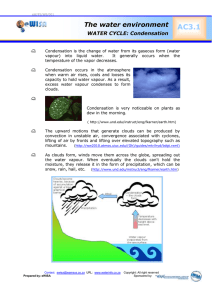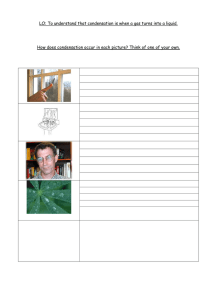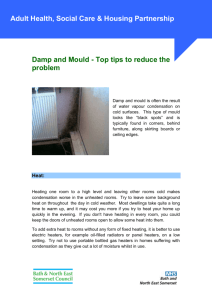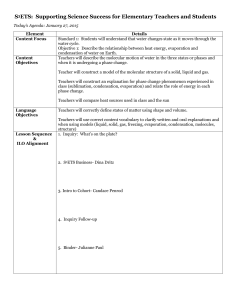Condensation in homes
advertisement
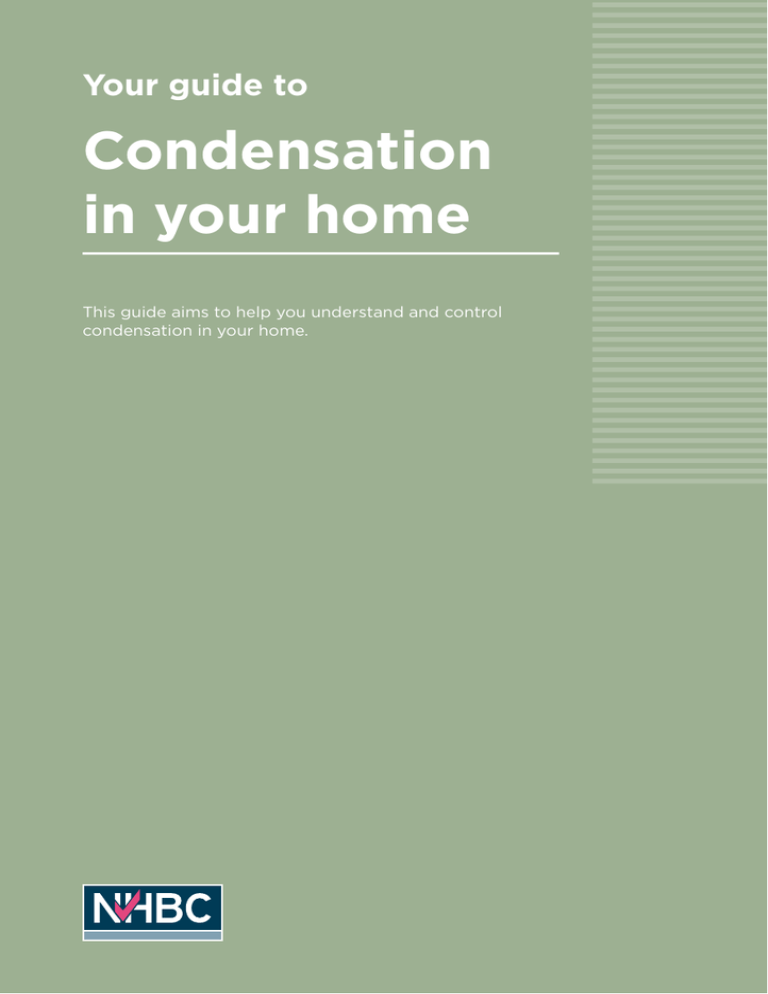
Your guide to Condensation in your home This guide aims to help you understand and control condensation in your home. About condensation in your home Condensation is caused when water vapour comes into contact with cold surfaces and condenses to form dampness or water droplets. Air can contain varying amounts of water vapour; warm air can hold more water vapour than cold air. When warm air comes into contact with a colder surface, it cools down and can’t retain the same amount of water vapour. The excess water vapour is released and forms condensation. Water vapour is invisible in air and is formed when you breathe and when you carry out normal daily activities in the home. It’s also formed as the materials used in your home’s construction dry out. Condensation in the home Condensation isn’t normally a building fault. It can occur in a new home because building materials, such as mortar and plaster, contain a lot of moisture. Water vapour is formed as the materials dry out when the home is lived in and heated. This is a slow process that takes some time to complete. Modern homes are built so that they don’t waste energy. Better insulation, draughtproofing on doors and sealed window units minimise draughts and stop heat escaping from your home. But they also reduce water vapour escaping, which can increase the risk of condensation. Normal daily activities (such as taking showers and baths, washing and drying clothes, cooking and boiling kettles) produce warm air containing a large amount of water vapour. If the warm air can’t escape through an open window or air vent, it moves around until it finds a cold surface where it cools and forms condensation. Homes that are heated intermittently are more likely to suffer with condensation Your guide to condensation problems than homes that are heated continuously. This is because continuous heating keeps the surfaces of the rooms warm, which reduces the risk of condensation forming on them. Condensation is most likely to appear on windows, colder parts of walls, around external door and window openings, and where ceilings and floors meet with outer walls. It can also appear in areas where air circulation is restricted, such as inside cupboards and behind furniture that is placed against an outside wall. If condensation keeps on occurring in the same place, it can sometimes cause black mould growth. Reducing condensation Controlling water vapour levels is important when living in modern, well insulated homes. You’re unlikely to prevent condensation in your home completely, but you should aim to reduce it to a level so that it doesn’t cause problems. The following advice should help you to achieve this. Produce less moisture • Put lids on saucepans while you’re cooking to reduce the amount of steam. • Avoid drying laundry on a clothes airer or radiator. If you need to dry clothes indoors, open the window and close the door of the room where the clothes are drying, so that moisture can escape outside rather than circulate around your home. • If you use a vented tumble drier, make sure it’s properly vented to an open window or through an outside wall. Stop moisture spreading • While cooking, bathing or washing, use an extractor fan and/or open a window, and keep the door closed. Keep the extractor fan on and/or the window open for about 20 minutes after you have finished (with the door closed). • When condensation appears, wipe it away. Ventilate moisture away • Leave trickle vents (slotted vents in the window frames) open when rooms are occupied – even in the winter when your heating is on. These vents provide constant ventilation which removes water vapour. • If you can, put free-standing wardrobes and other furniture against internal walls, leaving a gap between the wall and the furniture so that air can circulate around the room. Try not to overfill cupboards, wardrobes and drawers so that air can circulate around the contents. Provide even heating • Keep your home warm to avoid cold surfaces, and remember that it can take a long time for a building to warm up. • If your home is unoccupied during the day, make sure the timer is set so that your home is warm by the time you return. During very cold weather it’s better to leave the heating on during the day to maintain an even temperature. The temperature can be set a few degrees lower while you’re out and turned up when you return. • If you don’t usually use all of the rooms in your home, you should still keep them heated to avoid cold areas. It’s better to keep all rooms heated to a low temperature than to have some rooms heated to a high temperature while others have the heating turned off. Treating mould If you notice mould growing in your home, you should treat it straight away to stop it from spreading and causing more damage to your home. • Sterilise the affected area with a suitable fungicidal wash (available from most DIY stores), following the manufacturer’s instructions. Keep checking the affected area for at least a week. If the mould reappears, wash it down again with the fungicidal wash to make sure the area is thoroughly sterilised. • If the treatment appears to have been successful, you can carry out any necessary redecoration. If painting, use a good quality fungicidal paint to help prevent mould, but remember that this won’t be effective if it’s later covered by ordinary paint or wallpaper. If wallpapering, use a paste containing a fungicide to prevent further mould growth. • If mould or mildew is growing on clothing or carpets, you should dry clean them. Don’t disturb mould by brushing or vacuum cleaning, as you can increase the risk of respiratory problems. • To prevent mould returning, make sure that you control condensation in your home. Need more advice? If you have a severe case of condensation in your home, which doesn’t improve by following the guidance in this leaflet, contact us for more advice. Call us on 0800 035 6422 or email us at ‘claims@nhbc.co.uk’. Call us on 0800 035 6422 or email us at claims@nhbc.co.uk. NHBC is authorised by the Prudential Regulation Authority and regulated by the Financial Conduct Authority and the Prudential Regulation Authority. NHBC Claims, NHBC House, Davy Avenue, Knowlhill, Milton Keynes, Bucks MK5 8FP Tel: 0800 035 6422 www.nhbc.co.uk NHBC is registered in England and Wales under company number 00320784. NHBC’s registered address is NHBC House, Davy Avenue, Knowlhill, Milton Keynes, Bucks, MK5 8FP. This leaflet has been printed on material which is produced from well-managed forests and is fully recyclable and biodegradable, ECF (elemental chlorine free) and is made to ISO 14001 Environmental Certification. Copyright© NHBC 2016 HB1838 05/16
